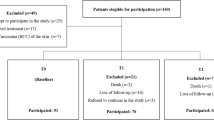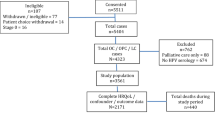Abstract
The assessment and evaluation of functioning and quality of life after tumor treatment in head and neck cancer (HNC) are considered as essential aspects of clinical routine and studies. A huge number of instruments are available that have been designed to evaluate functioning and quality of life after HNC treatment. The diversity of these instruments in terms of content, response options and administration hinders the comparability of available studies and the performance of meta-analyses. The objective of this paper is to inform about the development of a screening tool for the standardized assessment and evaluation of functioning based on the International Classification of Functioning, Disability and Health (ICF) Core Set for HNC. We followed a multi-step approach including (1) preparatory studies to identify and preselect suitable instruments for the assessment of functioning, (2) a decision-making process to agree on an ICF-based clinical guideline including instruments assessing functioning and (3) the development of a computer-based standardized screening tool to assess and evaluate functioning based on this guideline in clinical routine. Twenty-one experts participated in a consensus meeting and decided on instruments to be included in an ICF-based clinical guideline and screening tool for the assessment and evaluation of functioning in HNC patients in cancer treatment. The chosen instruments cover all aspects of the ICF Core Set for HNC addressing therapy control, pain, food intake/swallowing, voice/speech/breathing, other somatic complaints and psychosocial aspects. The screening tool contains patient-reported outcome measures and a clinician’s checklist. It has to be further tested in clinical practice.


Similar content being viewed by others
References
Ferlay J, Steliarova-Foucher E, Lortet-Tieulent J, Rosso S, Coebergh JWW, Comber H, Forman D, Bray F (2013) Cancer incidence and mortality patterns in Europe: estimates for 40 countries in 2012. Eur J Cancer 49(6):1374–1403. doi:10.1016/j.ejca.2012.12.027
Bjordal K, Ahlner-Elmqvist M, Hammerlid E, Boysen M, Evensen JF, Biörklund A, Jannert M, Westin T, Kaasa S (2001) A prospective study of quality of life in head and neck cancer patients. Part II: longitudinal data. Laryngoscope 111(8):1440–1452
Denis F, Garaud P, Bardet E, Alfonsi M, Sire C, Germain T, Bergerot P, Rhein B, Tortochaux J, Oudinot P, Calais G (2003) Late toxicity results of the GORTEC 94-01 randomized trial comparing radiotherapy with concomitant radiochemotherapy for advanced-stage oropharynx carcinoma: comparison of LENT/SOMA, RTOG/EORTC, and NCI-CTC scoring systems. Int J Radiat Oncol Biol Phys 55(1):93–98. doi:10.1016/S0360-3016(02)03819-1
Langmore S, Krisciunas G (2010) Dysphagia after radiotherapy for head and neck cancer: etiology, clinical presentation, and efficacy of current treatments. Perspect Swallowing Swallowing Disord (Dysphagia) 19(2):32–38. doi:10.1044/sasd19.2.32
Vilaseca I, Chen AY, Backscheider AG (2006) Long-term quality of life after total laryngectomy. Head Neck 28(4):313–320. doi:10.1002/hed.20268
Vissink A, Mitchell JB, Baum BJ, Limesand KH, Jensen SB, Fox PC, Elting LS, Langendijk JA, Coppes RP, Reyland ME (2010) Clinical management of salivary gland hypofunction and xerostomia in head-and-neck cancer patients: successes and barriers. Int J Radiat Oncol Biol Phys 78(4):983–991. doi:10.1016/j.ijrobp.2010.06.052
Abendstein H, Nordgren M, Boysen M, Jannert M, Silander E, Ahlner-Elmqvist M, Hammerlid E, Bjordal K (2005) Quality of life and head and neck cancer: a 5 year prospective study. Laryngoscope 115(12):2183–2192. doi:10.1097/01.MLG.0000181507.69620.14
Chaplin JM, Morton RP (1999) A prospective, longitudinal study of pain in head and neck cancer patients. Head Neck 21(6):531–537
Rogers SN, Harvey-Woodworth CN, Hare J, Leong P, Lowe D (2012) Patients´ perception of the financial impact of head and neck cancer and the relationship to health related quality of life. Br J Oral Maxillofac Surg 50(5):410–416. doi:10.1016/j.bjoms.2011.07.026
Verdonck-de Leeuw IM, van Bleek W-J, René Leemans C, de Bree R (2010) Employment and return to work in head and neck cancer survivors. Oral Oncol 46(1):56–60. doi:10.1016/j.oraloncology.2009.11.001
Lefebvre JL (2006) Laryngeal preservation in head and neck cancer: multidisciplinary approach. Lancet Oncol 7(9):747–755. doi:10.1016/S1470-2045(06)70860-9
Bozec A, Poissonnet G, Chamorev E, Casanova C, Laout C, Vallicioni J, Demard F, Peyrade F, Follana P, Bensadoun RJ, Benezery K, Thariat J, Marcy PY, Sudaka A, Weber P, Dassonville O (2009) Quality of life after oral and oropharyngeal reconstruction with a radial forearm free flap: prospective study. J Otolaryngol Head Neck Surg 38(3):401–408
Roe JWG, Carding PN, Dwivedi RC, Kazi RA, Rhys-Evans PH, Harrington KJ, Nutting CM (2010) Swallowing outcomes following Intensity modulated radiation therapy (IMRT) for head and neck cancer - a systematic review. Oral Oncol 46(10):727–733. doi:10.1016/j.oraloncology.2010.07.012
Kanatas AN, Rogers SN (2010) A systematic review of patient self-completed questionnaires suitable for oral and maxillofacial surgery. Br J Oral Maxillofac Surg 48(8):579–590. doi:10.1016/j.bjoms.2009.12.004
Rogers SN, Ahad SA, Murphy AP (2007) A structured review and theme analysis of papers published on “quality of life” in head and neck cancer: 2000-2005. Oral Oncol 43(9):843–868. doi:10.1016/j.oraloncology.2007.02.006
Tschiesner U, Rogers SN, Harreus U, Berghaus A, Cieza A (2009) Comparison of outcome measures in head and neck cancer: a literature review 2000–2006. Head Neck 31(2):251–259. doi:10.1002/hed.20960
Paleri V, Thomas L, Basavaiah N, Drinnan M, Mehanna H, Jones T (2011) Oncologic outcomes of open conservation laryngectomy for radiorecurrent laryngeal carcinoma. Cancer 117(12):2668–2676. doi:10.1002/cncr.25831
Mehanna HM, Morton RP (2006) Why are head and neck cancer clinicians not measuring quality of life? J Laryngol Otol 120(10):861–864. doi:10.1017/S0022215106001411
Wright EP, Selby PJ, Crawford M, Gillibrand A, Johnston C, Perren TJ, Rush R, Smith A, Velikova G, Watson K, Gould A (2003) Feasibility and compliance of automated measurement of quality of life in oncology practice. J Clin Oncol 21(2):374–382
World Health Organization (2001) International classification of functioning, disability and health: ICF. WHO, Geneva
Ustun TB, Chatterji S, Kostanjsek N, Rehm J, Kennedy C, Epping-Jordan J, Saxena S, von Korff M, Pull C, Project WNJ (2010) Developing the World Health Organization Disability Assessment Schedule 2.0. Bull World Health Organ 88(11):815–823. doi:10.2471/BLT.09.067231
Tschiesner U, Linseisen E, Becker S, Mast G, Rogers SN, Walvekar RR, Berghaus A, Cieza A (2010) Content validation of the International Classification of Functioning, Disability and Health Core Sets for Head and Neck Cancer: A Multicentre Study. J Otolaryngol Head Neck Surg 39(6):674–687
Tschiesner U, Rogers S, Dietz A, Yueh B, Cieza A (2010) Development of ICF core sets for head and neck cancer. Head Neck 32(2):210–220. doi:10.1002/hed.21172
Kirschneck M, Sabariego C, Singer S, Tschiesner U (2014) Assessment of functional outcomes in patients with head and neck cancer according to the International Classification of Functioning, Disability and Health Core Sets from the perspective of the multi-professional team: Results of 4 Delphi surveys. Head Neck 36(7):954–968. doi:10.1002/hed.23399
Stier-Jarmer M, Sabariego C, Cieza A, Harréus U, Tschiesner U (2014) Assessment of functional outcomes in head and neck cancer. Eur Arch Otorhinolaryngol 271(7):2021–2044. doi:10.1007/s00405-013-2744-1
Engelbarts M, Holtfreter V, Kisser U, Sabariego C, Stier-Jarmer M, Coenen M, Ernst BP, Strieth S, Harréus UA, Becker S Content validation of the Comprehensive ICF Core Set for Head and Neck Cancer: The perspective of speech and language therapists. In peer review
Sneeuw KCA, Aaronson NK, Sprangers MAG, Detmar SB, Wever LDV, Schornagel JH (1998) Comparison of patient and proxy EORTC QLQ-C30 ratings in assessing the quality of life of cancer patients. J Clin Epidemiol 51(7):617–631. doi:10.1016/S0895-4356(98)00040-7
Belafsky PC, Mouadeb DA, Rees CJ, Pryor JC, Postma GN, Allen J, Leonard RJ (2008) Validity and reliability of the Eating Assessment Tool (EAT-10). Ann Otol Rhinol Laryngol 117(12):919–924
Aaronson NK, Ahmedzai S, Bergman B, Bullinger M, Cull A, Duez NJ, Filiberti A, Flechtner H, Fleishman SB, Haes JCJMd, Kaasa S, Klee M, Osoba D, Razavi D, Rofe PB, Schraub S, Sneeuw K, Sullivan M, Takeda F (1993) The European Organization for Research and Treatment of Cancer QLQ-C30: a quality-of-life instrument for use in international clinical trials in oncology. J Natl Cancer Inst 85(5):365–376. doi:10.1093/jnci/85.5.365
Kroenke K, Spitzer RL, Williams JBW, Monahan PO, Löwe B (2007) Anxiety disorders in primary care: prevalence, impairment, comorbidity and detection. Ann Intern Med 146(5):317–325. doi:10.7326/0003-4819-146-5-200703060-00004
Chair for Public Health and Health Services Research (2011) Assessing functional outcomes after treatment of head and neck cancer—Recommendations of an interdisciplinary expert committee (as of Oct 2011). http://ihrs-en.ibe.med.uni-muenchen.de/biopsychosocial/completed/icf_kopf_hals_tumore/table_clinicaltrailsv3engl.pdf. Accessed September 20, 2016
Verdonck-de Leeuw IM, de Bree R, Keizer AL, Houffelaar T, Cuijpers P, van der Linden MH, Leemans CR (2009) Computerized prospective screening for high levels of emotional distress in head and neck cancer patients and referral rate to psychosocial care. Oral Oncol 45(10):e129–e133. doi:10.1016/j.oraloncology.2009.01.012
Tschiesner U, Linseisen E, Coenen M, Rogers S, Harreus U, Berghaus A, Cieza A (2009) Evaluating sequelae after head and neck cancer from the patient perspective with the help of the International Classification of Functioning. Disability and Health. Eur Arch Otorhinolaryngol 266(3):425–436. doi:10.1007/s00405-008-0764-z
Author information
Authors and Affiliations
Corresponding author
Ethics declarations
Funding
The project was funded by the “Deutsche Krebshilfe e. V.”.
Conflict of interest
The authors declare that they have no conflict of interest. The Authors have no financial relationship with the organization that sponsored the research.
Research involving human participants and/or animals
This article does not contain any studies with human participants or animals performed by any of the authors.
Informed consent
Not applicable (no patient data reported).
Electronic supplementary material
Below is the link to the electronic supplementary material.
405_2016_4317_MOESM1_ESM.pdf
The development of an ICF-based clinical guideline and screening tool for the standardized assessment and evaluation of functioning after head and neck cancer treatment (PDF 208 kb)
Rights and permissions
About this article
Cite this article
Kisser, U., Adderson-Kisser, C., Coenen, M. et al. The development of an ICF-based clinical guideline and screening tool for the standardized assessment and evaluation of functioning after head and neck cancer treatment. Eur Arch Otorhinolaryngol 274, 1035–1043 (2017). https://doi.org/10.1007/s00405-016-4317-6
Received:
Accepted:
Published:
Issue Date:
DOI: https://doi.org/10.1007/s00405-016-4317-6




